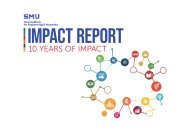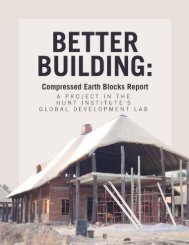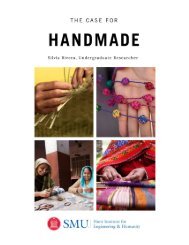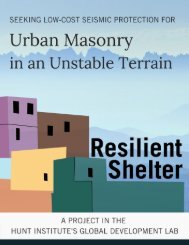Building Fences to Build Connections
Kasisa Village is a rural village in the East African country of Tanzania. This project is designed to improve the quality of life of its residents. Clara Ford, founder of Kijiji Innovative Sustainable Solutions (KISS), has directed her efforts toward building a community center with goals of reducing cyclical poverty and empowering the local people with technical skills. The locals of Kasisa Village are stakeholders in the planned center, which will function as a testing ground for social impact implementation in their community. This partnership for community development is a core value for Ford, the KISS Board of Directors, and the Hunt Institute.
Kasisa Village is a rural village in the East African country of Tanzania. This project is designed to improve the quality of life of its residents. Clara Ford, founder of Kijiji Innovative Sustainable Solutions (KISS), has directed her efforts toward building a community center with goals of reducing cyclical poverty and empowering the local people with technical skills. The locals of Kasisa Village are stakeholders in the planned center, which will function as a testing ground for social impact implementation in their community. This partnership for community development is a core value for Ford, the KISS Board of Directors, and the Hunt Institute.
You also want an ePaper? Increase the reach of your titles
YUMPU automatically turns print PDFs into web optimized ePapers that Google loves.
Building Fences to Build Connections
Affiliate:
Dr. Jessie Zarazaga
In-country Partner:
Clara Ford
Undergraduate Project Manager:
Taylor Grace
Undergraduate Research Analyst:
Izzah Zaheer
Southern Methodist University
Lyle School of Engineering
Hunter and Stephanie Hunt Institute for Engineering and Humanity
Global Development Lab
Summer 2020
Izzah Zaheer, Hunt Institute Undergraduate Research Analyst Page 1
Building Fences to Build Connections
Table of Contents
INTRODUCTION ............................................................................................................................................................................. 4
DESCRIPTION OF KASISA VILLAGE ............................................................................................................................................. 7
The Standard Options in Kasisa ........................................................................................................................................ 8
What is a Sustainable Option? ........................................................................................................................................ 10
OUR PROPOSALS: ....................................................................................................................................................................... 13
Option 1: ................................................................................................................................................................................... 13
Option 2: ................................................................................................................................................................................... 15
COST ANALYSIS: ......................................................................................................................................................................... 17
CONCLUDING OBSERVATIONS .................................................................................................................................................. 18
REFERENCES ............................................................................................................................................................................... 19
Izzah Zaheer, Hunt Institute Undergraduate Research Analyst Page 2
Building Fences to Build Connections
“A country like Tanzania, blessed with so much wealth in natural resources, shouldn’t
have its citizens living in any state of poverty. If such resources are allocated properly,
Tanzania has the capacity to ensure all of its people are in better living standard than
they currently are.”
Clara Ford, CEO of Kijiji Innovative Sustainable Solutions
Izzah Zaheer, Hunt Institute Undergraduate Research Analyst Page 3
Building Fences to Build Connections
Figure 1: Kasisa Village stakeholders
Introduction
The Hunt Institute’s Global Development Lab partnered with Jessie Zarazaga,
PhD, Director of the Master of Arts in Sustainability and Development from Lyle School
of Engineering, to work with Clara Ford, Founder, President, and CEO of Kijiji Innovative
Sustainable Solutions (KISS) and MASD alumni on what we call the Kijiji Project.
Born in Kasisa Village, a rural village in the East African country of Tanzania, Ford
is especially motivated to improve the quality of life of its residents. Ford has directed her
efforts toward building a community center with goals of reducing cyclical poverty and
empowering the local people with technical skills. The locals of Kasisa Village are
stakeholders in the planned center, which will function as a testing ground for social
impact implementation in their community. This partnership for community development
is a core value for Ford, the KISS Board of Directors, and the Hunt Institute.
Zarazaga explains the importance of this project, saying, “The energy and focus
invested in the Kijiji project is valuable for the village of Kasisa, Tanzania, but it is equally
valuable for the skills of my students, as future sustainability professionals. It is not
Izzah Zaheer, Hunt Institute Undergraduate Research Analyst Page 4
Building Fences to Build Connections
enough to talk about sustainability, it is not an abstract activity. Each solution is
embedded in a real situation with people and territory; this is where learning takes place.”
This project experienced considerable delays at the onset of the Spring Semester’s
COVID-19 response, including a canceled trip to a conference for Zarazaga, a campus
shutdown, and the steep learning curve for doing remote work on a global scale. Despite
these challenges, Zarazaga says, “Covid, and the necessity to work at a distance, made
us learn how much we really can do remotely. Now we see that connecting to Dar es
Salaam (near the Kasisa village) is no harder than connecting to my office at SMU. Our
way of collaborating is changing: we are working with Tanzanian students and
professionals more than we had planned or anticipated; this is good for the sustainability
of the project in powerful ways.”
Phase I of the project was completed over the summer of 2020 focusing on the
development of a sustainable fence for the community center Ford aspires to build in
Kasisa. Over 8000 miles away or an 18 hours flight from Kasisa the team pushed through
leveraging technology to keep the lines of communication open. Undergraduate Research
Analyst Izzah Zaheer and Undergraduate Project Manager Taylor Grace worked with Dr.
Jessie Zarazaga, and Clara to develop a fence that is economically and ecologically
sustainable. “I was put on this team right after I was hired to the Institute over the summer.
Dealing with a new role, a new project, and a new environment with COVID was a lot to
take on. However, with the support and guidance of my team and the understanding of
the impact this community center would have on the village, I researched and looked at
the best sustainable solutions for this fence,” said Izzah Zaheer.
Izzah Zaheer, Hunt Institute Undergraduate Research Analyst Page 5
Building Fences to Build Connections
The goal of Phase I was to find a solution that could be integrated into this specific
community and replicated in other surrounding communities. Starting with the fence is
crucial to ensure that the land for the future community center will be protected from
livestock eating and damaging vegetation. This report outlines the findings.
The purpose of this report is to determine the best practices for building a fence to
protect the land bought for the community center from animals in the area, specifically the
cattle that graze and may eat the trees planted on this land. Additionally, the fence needs
to be environmentally, culturally, and economically sustainable in order for the local
community to maintain this perimeter. This fence represents Phase 1 in creating a more
sustainable structure in the Kasisa village and a community center through the Kijiji Non-
Profit Innovative Sustainable Solutions (KISS) (Ford 2019).
The three sustainable fence solutions were presented to the KISS board for review.
“I really enjoyed presenting our findings to the KISS board and local Tanzanians because
they were pleased with our solution. It was the first time we had had the chance to connect
with the visionaries of this project. Their passion and excitement to improve this
community, combined with their resourcefulness, encouraged me and made me so
honored to be a part of such an amazing project that will impact so many lives,” said
Taylor Grace, undergraduate project manager.
To learn more about this project and its future phases, visit the Hunt Institute
Digest.
Izzah Zaheer, Hunt Institute Undergraduate Research Analyst Page 6
Building Fences to Build Connections
Description of Kasisa Village
Kasisa Village is in the United Republic of Tanzania located in the Wakiso District
within the Mwanza Region. Within the Kasisa village, there is no formal plan of
development. Mwanza’s population is one of the one of the largest growth rates.
Although, Kasisa has approximately 8,780 people. The village represents less than 1%
of the national population because of urban migration. Over 70% of household’s income
is generated by agriculture or fishing because of fertile soil and Lake Victoria (Ford 2019).
Therefore, the economy is dependent on agriculture. Changes in climate and poor harvest
seasons present a danger to the stability of households in the village. Therefore, this
center and building the fence around the center with sustainable methods will help the
village.
Figure 2: Kasisa Village location
Izzah Zaheer, Hunt Institute Undergraduate Research Analyst Page 7
Building Fences to Build Connections
Figure 3: Standard enclosures in Kasisa
The Standard Options in Kasisa
The standard solution for a fence or enclosure in Kasisa is typically wire fencing
combined with concrete posts with cement bricks due to security concerns. However, we
want to institute a more sustainable solution for the village since the cement bricks and
concrete posts are not environmentally sustainable due to the heat from sunlight
reflection. Additionally, the materials for this fence are not sourced locally (Ford 2019).
Izzah Zaheer, Hunt Institute Undergraduate Research Analyst Page 8
Building Fences to Build Connections
PROS
Would stop cows from wandering into
property
Good for security
CONS
Not environmentally sustainable
Would require getting materials not locally
sourced
Another standard option in Kasisa is the use of chain link fences. These fences
successfully act as an enclosure for an area and can prevent animals, such as cows from
wandering onto the land. When comparing standard solutions, chain link fences are more
favorable than cement and wire fencing. They are more cost effective and will not heat
up the area around them due to the sunlight.
Pros
Would stop cows from wandering into
property
Cons
Not the most sustainable option
Cost Effective
Izzah Zaheer, Hunt Institute Undergraduate Research Analyst Page 9
Building Fences to Build Connections
Figure 4: African Myrrh tree
What is a Sustainable Option?
Sustainable efforts are meant to balance ecological, cultural, and economic needs.
The goal of this balance is to contribute to development that can be recreated and
continued by locals (Nelson 2000). In order to ensure that this fence can be maintained
by the local village, we want to make sure that it is built with local and environmentally
friendly materials. A sustainable fence would be a perimeter that can be reproduced
locally as well as economically and environmentally sustainable for the community.
Izzah Zaheer, Hunt Institute Undergraduate Research Analyst Page 10
Building Fences to Build Connections
Living Wall Fence
Pros
Would not have to be replaced as the
trees would grow to enforce the barrier
Cons
Labor intensive installing fence posts and
chain link fence
Have more aesthetic value
The Living Wall fence is a method used with the Masai tribe as well as other parts
of Kenya and northern Tanzania. It involves taking the dried-out limbs of the African Myrrh
tree and planting them into the ground like fence posts. (Schiffman 2014). The African
Myrrh tree is common to eastern and northeastern tropical Africa and typically grows up
to 5 meters (16 ft) and 1.5m wide. Direct sun exposure is preferable, thus making it
drought tolerant. All of these characteristics make it a suitable choice for the living wall
and sustainable solution for the local community.
Once these tree limbs are planted into the ground, the chain link fence is
intertwined with the limbs. Over time, the trees will mature in 2 years and become
interlocked, making it difficult for animals to enter the enclosed area. The enclosure is
more secure and impenetrable unlike chain link fences alone. When the limbs are placed,
they already form an enclosure and the continued growth just reinforces the perimeter.
Beehive Fencing
Pros
Deter animals from the trees planted
Not aesthetic
Cons
Dummy beehives can be placed
While the beehives are in place, visitors
have to be careful with the hives
Not proven that they deter cows
Izzah Zaheer, Hunt Institute Undergraduate Research Analyst Page 11
Building Fences to Build Connections
Beehive Fencing has been used in Kenya and Tanzania with the purpose of
deterring elephants from crops around Serengeti in Northern Tanzania, specifically
(Gottlieb 2017). These beehive fences can be used to deter cows from eating the trees
within the perimeter. Additionally, the beehives would not have to be there permanently.
In prior applications, once the animals developed an aversion to the sight of the beehives,
dummy beehives were enough to keep them away.
Chili-Oil Fencing
Pros
Bothers surrounding animals due to
strong smell
Irritates animals’ olfactory senses and
keeps them away from the trees
Cons
Not aesthetically pleasing
Can be potentially irritating to humans
Not proven that they deter cows
Chili fencing involves placing fence posts and connecting them with rope. Then,
grinding dried chilies into fine powder and mixing it with oil. This chili-oil mixture gets
dipped in cloth and then hung on the rope that is strung between the fence poles (Gottlieb
2017).
Izzah Zaheer, Hunt Institute Undergraduate Research Analyst Page 12
Building Fences to Build Connections
Our Proposals:
Option 1:
For the fencing around the community center, we propose a mixed purpose as
modeled on the figure down above. On the perimeters marked in green, we propose a
living wall fence, which would be sustainable and has been used in areas of Northern
Tanzania too.
Figure 5: Source Google Maps
Legend
Living Wall Fence
Standard Chain Link Fence
Gates (not drawn to scale)
Izzah Zaheer, Hunt Institute Undergraduate Research Analyst Page 13
Building Fences to Build Connections
For the fencing around the community center, we propose a mixed purpose as
modeled on the figure down above. On the perimeters marked in green, we propose a
living wall fence, which would be sustainable and has been used in areas of Northern
Tanzania too. By planting limbs of the native African myrrh tree along the perimeter as
fence posts 8-10 feet apart and connecting them with chain link, we create a barrier that
will keep out livestock and prevent them from wandering into the land. The living wall
fence satisfies the need for the perimeter to appear aesthetic once the trees mature in 2-
3 years. Additionally, this method has proven to be cost effective since the tree limbs and
chain link can be sourced locally. Finally, in terms of environmental sustainability, growing
trees contributes to the overall environment of Kasisa and is a solution that involves
minimal disruption to the land in the area.
However, living wall fences tend to block the view inside the area they surround.
For that reason, it would be difficult to see inside the center from the front and difficult to
see the lake from the back.
For cost and labor purposes, we propose having the standard chain link fence
along the side of the perimeter marked with grey. Installing a living wall fence around the
entire perimeter would be extremely laborious. By having a standard chain link fence
there, it provides enclosure and leaves the opportunity to convert into a living wall fence
in the future.
Izzah Zaheer, Hunt Institute Undergraduate Research Analyst Page 14
Building Fences to Build Connections
Option 2:
Figure 6: Source Google Maps
Legend
Living Wall Fence
Standard Chain Link Fence
Gates (not drawn to scale)
Although based on our research, Option 1 would be the most cost effective, while
still giving weight to sustainability, the image above presents another viable option. In this
scenario, the living wall fence would be on the green portions of the perimeter as shown
above, while the grey portions contain the chain link fence.
This would be beneficial by allowing more visibility at the front of the center.
However, most of the cows try to enter from the front and the back of the center, thus the
chain link fence will not be as efficient as the living wall fence. Additionally, this would be
Izzah Zaheer, Hunt Institute Undergraduate Research Analyst Page 15
Building Fences to Build Connections
more laborious and require more work when first installing the living wall fence since there
is more area to cover.
Although the beehive fence and chili oil fence would be preferable in terms of
sustainability, these fences have mainly been used to deter elephants and not cows.
There is no evidence that these fences are effective in deterring cows. Therefore,
installing those types of fences around the perimeter would be an experiment rather than
a certain solution.
In addition to this fencing, we also propose planting wax myrtle shrubs around the
compound. These plants irritate livestock and keep them away from the area that they
are planted (Duran 2019). Therefore, this will act as a deterrent against the cows in the
area. These plants are very common and can be found in areas of Africa. These shrubs
can be planted 5-8 feet away from the fence. When cows come and try to eat the shrub
and are averse to it, they will frequent the area less and less.
Figure 7: An example of shrubs in front of an enclosure
Izzah Zaheer, Hunt Institute Undergraduate Research Analyst Page 16
Building Fences to Build Connections
Cost Analysis:
Given the perimeter of the land, we need 1305.8 meters of chain link fence to go
around. For option 1, the living wall fence requires that the tree limbs are planted every 8
to 10 feet or every 2.44 meters to 3.05 meters. Considering this, we would need
approximately 53 to 67 limbs for the front of the center and 80 to 100 limbs for the back.
For option 2, the living wall fence will also require tree limbs planted every 8 to 10
feet along the perimeters on the side of the land. Therefore, we would need approximately
138 to 174 tree limbs for the side at the top of the map and 170 to 213 tree limbs for the
side at the bottom of the map.
At this stage, we are ready to determine the cost of the chain link fence needed
and the African myrrh tree limbs needed in order to complete this fence:
Items Needed Minimum Maximum Minimum Maximum
Amount Needed Amount Needed Cost* Cost*
Chain Link 1305.8 meters N/A ? ?
African Myrrh Tree
Limbs (Option 1)
African Myrrh Tree
Limbs (Option 2)
133 167 ? ?
308 387 ? ?
*Due to the COVID-19 global pandemic, contact with hardware stores in Tanzania was
not possible and we were unable to find a website that lists pricing.
Izzah Zaheer, Hunt Institute Undergraduate Research Analyst Page 17
Building Fences to Build Connections
Concluding Observations
The goal of the best practices research was to determine which methods of fencing
will be successful in terms of environmental, economic, and cultural sustainability. I
determined three methods of unique and sustainable fencing such as a living wall fence,
a beehive fence, and a chili-oil fence, while also considering the standard option of a
chain link fence. Considering these options, I moved forth with two recommendations
enumerated in option 1 and option 2 above. Option 1 entails a living wall fence along the
front and back of the center, while chain link covers the perimeter on the side. Option 2
is the inverse and involves a living wall fence along the side, while using a chain link fence
for the front and back, both options give weight to sustainability and cost effectiveness.
At this point in the analysis, it would be crucial to move forward and collect exact
pricing for the cost of the chain link fence and African myrrh tree limbs to get a better
picture of costs as the project moves towards implementation.
Izzah Zaheer, Hunt Institute Undergraduate Research Analyst Page 18
Building Fences to Build Connections
Table of Figures
Figure 1: Kasisa Village stakeholders ................................................................... 4
Figure 2: Kasisa Village location ........................................................................... 7
Figure 3: Standard enclosures in Kasisa ............................................................... 8
Figure 4: African Myrrh tree ................................................................................. 10
Figure 5: Source Google Maps ............................................................................ 13
Figure 6: Source Google Maps ............................................................................ 15
Figure 7: An example of shrubs in front of an enclosure ..................................... 16
Izzah Zaheer, Hunt Institute Undergraduate Research Analyst Page 19
Building Fences to Build Connections
References
Author Unknown. (2015). Empower Big Cats Conservation Today. Retrieved July 20,
2020, from
http://www.afrpw.org/initiatives/wildlife-conservation/
Duran, A. (2019, November 16). How to Stop Cows from Eating Plants: 5 Effective
Tips. Retrieved July 20, 2020, from
https://bestfarmanimals.com/how-to-stop-cows-from-eating-plants-5-effectivetips/
Ford, Rulegura Clara (2019). Kijiji Innovative Sustainable Solutions. Lyle School of
Engineering Master of Arts in Sustainability and Development Capstone.
Unpublished work.
Gottlieb, B. (2017, July 21). Beehives and Chili Fences Promote Elephant Conservation
in Tanzania. Retrieved July 20, 2020, from
https://fieldstudies.org/2016/02/beehives-and-chili-fences-promote-elephantconservation-in-tanzania/
Nelson, F. (2000, August 10). Sustainable Development and Wildlife Conservation in
Tanzanian Maasailand. Retrieved July 20, 2020, from
https://link.springer.com/article/10.1023/A:1011487017684
Nowak, K. (2018, August 22). Beehive fences and elephants: Tanzanian case study
offers fresh insights. Retrieved July 20, 2020, from
https://africasustainableconservation.com/2018/08/22/beehive-fences-andelephants-tanzanian-case-study-offers-fresh-insights/
Schiffman, R. (2014, April 07). Lion killing in Tanzania reduced by installation of 'living
wall' fences. Retrieved July 20, 2020, from
https://www.theguardian.com/environment/2014/apr/07/lion-killing-tanzaniareduced-installation-living-wall-fences-masai
Izzah Zaheer, Hunt Institute Undergraduate Research Analyst Page 20
Building Fences to Build Connections
Izzah Zaheer, Hunt Institute Undergraduate Research Analyst Page 21













